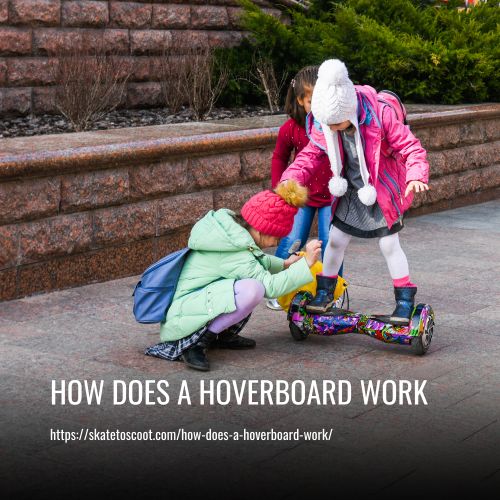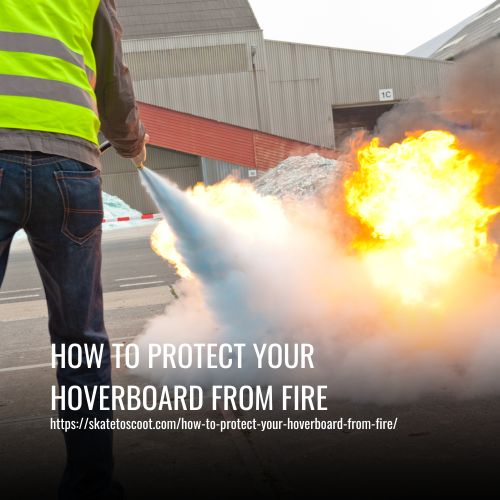As an Amazon Associate we earn from qualifying purchases.
Hoverboards work by using the rider’s center of gravity to direct the movement of the device. The internal gyroscope helps to detect and adjust the tilt of the board, ensuring that it remains balanced. This technology allows riders to effortlessly control their movements and navigate different terrains.
Furthermore, hoverboards are enabled with a microprocessor that manages the power supply to the wheels. This component allows the device to maintain a steady pace and avoid sudden movements that could result in potential accidents. The microprocessor is also responsible for regulating other features such as speed and braking mechanisms.

The Hoverboard Controversy
Hoverboards, which have been marketed as balance boards, self-balancing scooters, or Segways without handlebars, was one of the trendiest gifts last holiday season. However, they have recently been at the center of a controversy regarding their safety concerns due to exploding lithium-ion batteries and unstable control. As a result, these machines have been labeled as “unsafe for human use” by the Consumer Product Safety Commission (CPSC).
The controversy surrounding the hoverboard safety concerns is not entirely unwarranted. Negligent parents bought toys for their children that had as much stored potential energy as a stick of dynamite, resulting in serious injuries and in some cases, even death. It’s important to note that the safety concerns of hoverboards aren’t just limited to accidents caused by malfunctioning parts, but also extend to issues like inadequate power management and insufficient battery life.
However, the situation isn’t entirely black and white. While some hoverboards have been recalled due to their potential safety hazards, there are still a variety of models on the market that have received the CPSC stamp of approval. Moreover, the design and engineering of hoverboards have come a long way since the initial wave of products that suffered from faulty mechanisms.
Functionally How Hoverboard Work?
Hoverboards have gained immense popularity over the years, and the science behind their functioning has always piqued people’s curiosity. While it may seem like a simple device, a typical hoverboard contains a plethora of underlying technologies that work together to make it a self-balancing and fun personal transportation device. Here’s a breakdown of the essential components that make a hoverboard work.
1. Logic Board, Electric Motors, and Lithium-Ion Batteries:
At the core of a hoverboard lies the logic board. It is responsible for controlling the power of the electric motors that drive the wheels, maintaining balance, and sending signals from the sensors to the movement control. The motors turn the wheels, allowing the device to move forward, backward, or turn. To power the motors, a hoverboard uses a rechargeable lithium-ion battery. The battery’s capacity determines how far a rider can go on a single charge and how fast they can travel.
2. Sensors and Pressure Pads:
Hoverboards use a combination of sensors to maintain balance and stability. Infrared sensors located under the foot pads help detect the rider’s movement and shift their weight to keep the device balanced. Speed sensors help to measure the rider’s movements, adjusting the speed accordingly.
Pressure pads on the foot platforms make it possible to control the speed and direction of a hoverboard by shifting weight from one foot to the other. Additionally, the power switch usually mounted under the foot pad helps the rider to switch on the device quickly.
3. Main Parts of a Hoverboard:
A hoverboard is composed of several parts, with each part serving an essential role in its operation. The deck or footpads, motors, battery, and gyroscopes are the main parts of a hoverboard.
The deck or footpads hold the rider’s weight and allow them to steer the hoverboard by leaning in different directions. These footpads contain pressure sensors that detect the rider’s position and send signals to the logic board, which controls the hoverboard’s movements.
Motors are what power the hoverboard’s wheels, allowing it to move forward, backward, and in circles. Each wheel has its own motor, and the control board regulates these motors to ensure the rider’s safety.
Wheels / Motors
Hoverboards are designed with two wheels, each containing an electric motor that powers independent movement. These motors work together to propel the hoverboard forward, backward, or in circles at varying speeds. The wheels also house the speed sensor, which detects the RPM of each wheel and sends this information back to the control board.
The control board, also known as the logic board, is responsible for interpreting the speed data and tilt signals from the gyroscope. It uses this information to regulate the power range of each wheel, ensuring that the hoverboard maintains its desired speed and direction. As a result, the control board is a crucial component of the hoverboard and must be properly calibrated to achieve optimal performance.
Motherboard
The motherboard is a crucial component of the hoverboard’s electronic system. Once the sensors and gyroscopes measure the RPMs, speed, and tilt information, it is sent to the motherboard for processing. (Rephrase: Once the sensor acquires the data, it is processed by the Motherboard)
The motherboard works at an incredible speed processing millions of data bytes per second and signals back to the motors to take a specific action. (Rephrase: The motherboard’s processing speed is lightning fast, allowing it to process millions of data bytes at a time and signal the motors for specific actions)
Gyroscopes
Gyroscopes are without a doubt an integral part of any hoverboard, as they provide a crucial function for balance and orientation. These electronic devices are responsible for measuring the angular velocity and tilt of the hoverboard, allowing the rider to stay upright and maintain balance on the device.
When a rider leans forward, the pressure sensors on the footpads of the hoverboard detect this movement and work in conjunction with the gyroscopes to maintain balance and keep the rider moving forward smoothly. The gyroscopes receive information from the pressure sensors to determine how much power to send to the motors, which in turn dictates how fast the hoverboard moves.
Battery
The lithium-ion battery packs used in hoverboards play a crucial role in powering the device. These rechargeable batteries are lightweight, making them perfect for the portable hoverboard. Without these battery packs, the hoverboard cannot operate, balance, or move back and forth.
The capacity and lifespan of these batteries are also significant factors in determining the performance and longevity of the hoverboard. The capacity determines how long the battery can last on a single charge, while the lifespan decides how long the batteries will last before requiring replacement.
Pressure Pads
The pressure pads, located on top of a hoverboard, are the areas where a rider places their feet. Despite their simple appearance, the pressure pads are essential components of the hoverboard’s balancing system.
When a rider steps onto a hoverboard, the pressure pads are triggered, causing the two rubber pieces underneath to react with the gyroscopes as switches. These switches are connected to infrared LED sensors that tell the logic board to start balancing the rider.
Remote (Bonus Feature!)
In some models of hoverboards, a remote control is included that provides extra functionality to the rider. The primary function of the remote is to lock the hoverboard when not in use, ensuring that it cannot be used or moved without your permission.
Additionally, the remote control provides additional riding modes, such as a beginner’s mode for those who are just starting with their hoverboard. This mode reduces the maximum speed and sensitivity of the board, making it easier for new riders to get the hang of things.
Working of Hoverboards
Hoverboards are a popular mode of transportation that have taken the world by storm. These devices consist of a foot platform with two wheels, and riders control their movement through slight shifts in their body weight. While hoverboards may seem simple on the surface, various essential components work together to make them function. In the following sections, we will explore the science behind hoverboards and the crucial technology that makes them work.
1. The technology behind hoverboards:
Hoverboards are powered by a mix of technological components, including electric motors, lithium-ion batteries, infrared sensors, and speed sensors. At the heart of each hoverboard is a logic board that coordinates the actions of these different components, ensuring that the rider remains balanced and that the board moves according to their commands.
2. The science behind hoverboards:
Hoverboards work by manipulating magnetic fields through electrical power. Each wheel of the hoverboard operates independently, and as riders shift their weight, the board’s gyroscopic sensors detect this movement. These sensors then activate the motors to maintain balance and movement, respectively. All of these mechanisms work together to enable the rider to move effortlessly and smoothly on their hoverboard.
3. The importance of safety standards:
Hoverboards have come under scrutiny on account of their potential dangers to riders. To ensure rider safety, hoverboards undergo rigorous certification standards, including UL2272, which lays out guidelines for their electrical, mechanical, and fire safety. Manufacturers must adhere to these standards to ensure the hoverboards are safe for use on the road and conform to the required safety standards.
4. How does a hoverboard move forward and backward?
In order to achieve proper balance and keep a consistent speed, hoverboards rely on a combination of sensors, including the gyroscope, tilt sensor, and speed sensor. When a rider leans their toes or heels in a specific direction, the tilt sensor detects the movement and relays it to the logic board. The logic board then instructs the motor to activate, propelling the board in the direction of the rider’s lean.
This process happens during both forward and backward movement, with riders relying on their body weight and the hoverboard’s sensors to maintain balance and stay on course. The gyroscope plays a vital role in keeping the board stable, with the sensors detecting and responding to even the slightest shifts in weight distribution. This allows the rider to move smoothly and without significant interruption.
5. Stopping
When it comes to safety, stopping a hoverboard is just as important as starting it. To come to a halt without losing balance, IR sensors and pressure pads play a crucial role. These sensors detect when a rider is not tilting in any direction, and relay that information to the logic board.
Upon receiving the signal, the logic board instructs the motor to stop operating, which ultimately brings the hoverboard to a complete stop. This function is especially important in ensuring the rider’s safety, as it allows them to easily and quickly stop the device whenever necessary.
6. Turning
Turning on a hoverboard is a precise process that takes advantage of the board’s unique technology. Instead of turning both wheels, the board turns by only moving one. Depending on the direction the rider wants to turn in, they will move either their right or left leg forward, switching off the motor in the opposite wheel. This will allow the board to turn smoothly, without any abrupt movements or instability.
If the rider wishes to make a sharp, circular movement, they can tilt one leg forward while keeping the other leg in place. This will cause the board to rotate in a circle, allowing for some creative movement and control. When standing upright, riders should move their left leg to turn right and their right leg to turn left. By following these simple steps, riders can ensure that the board stays balanced and stable during the turning process, giving them a safe and enjoyable experience.
How Can Future Designs Improve?
Hoverboards are notorious for being difficult to maneuver outdoors because of their small wheels and lack of suspension. Bumps in the pavement or even small debris can cause riders to lose control and fall. Future designs may need to consider increasing wheel size or incorporating suspension features to improve stability. However, these changes would need to address the fundamental issues of higher power requirements and complicated sensor systems that are necessary to maintain balance.
Battery life is one of the main concerns with hoverboards. Many boards on the market offer only 90 minutes of charging time, which is not enough for everyday use. Future designs must focus on battery advancements to improve the performance and safety of these devices. Longer run times and better over-charge protection systems should be a top priority to avoid accidents caused by battery-related malfunctions.
To improve safety, hoverboards also need to meet stringent standards. Logic board advancements can help with this by incorporating infrared and magnetic technology to monitor speed and adjust for balance issues in real-time. This would be a significant improvement over the current sensors that sometimes cause footpads to jerk suddenly when encountering small bumps.
FAQs
Hoverboards resembling the one seen in Back to the Future 2 may not be a reality any time soon. However, various emerging technologies have led to successful working prototypes. It may likely take a few years to achieve the desired functionality.
Hoverboards may be named as such, but they don’t hover or fly. They function via gyroscopic sensors that enable riders to control their speed, thrust, and direction based on their balance. These sensors are aided by several essential components, including a logic board, lithium-ion batteries, electric motors, and infrared sensors for stability.
Through these components, a hoverboard’s electric charge is converted into powerful motors that move the device’s wheels forward or backward based on the rider’s dominant foot. Pressure pads on the foot platform detect the rider’s movements, while speed and foot switch control acceleration. In terms of safety standards, hoverboards must adhere to certain regulations regarding power management, maximum speed, and battery safety to ensure proper use.
Hoverboards are not hover or fly. They are scooters with components like logic boards, lithium-ion batteries, electric motors, infrared sensors, speed sensors, foot pads, and pressure pads to keep the rider balanced on two wheels.
Rumors of hoverboards that can truly soar, as seen in Back to the Future, remain unfounded. Current technology allows hoverboards to go up to 10 miles per hour. They’re equipped with powerful motors, magnetic fields, and LED lights. Power management is essential for a long-range trip on a single charge with lithium-ion batteries. Safety standards have been implemented in their production over the years.
Conclusion:
This article has provided a comprehensive guide on how hoverboards work. The various essential components of hoverboards such as logic boards, lithium-ion batteries, electric motors, infrared sensors, speed sensors, and footpads have been discussed in detail. We have also covered the significance of magnetic fields, power management, and safety standards to ensure rider balance and road safety.
This article can help readers understand the science behind hoverboards, balance board systems, and electronic devices’ power consumption. Furthermore, this article can assist readers in deciding on the appropriate type of hoverboard they need and ensure they have sufficient knowledge about the essential components of a standard hoverboard.
Amazon and the Amazon logo are trademarks of Amazon.com, Inc, or its affiliates.



